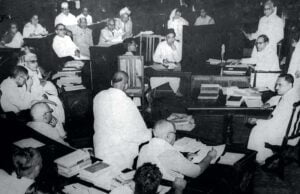The Government of India Act, 1935 was the last constitution of British India, before the country was divided into two parts, i.e, India and Pakistan. It was based on the recommendations of the Simon Commission, the Round Table Conferences, and the White Paper published by the British government. It introduced various reforms and changes in the administration and governance of India, such as:
- It planned to create an All India Federation that would include provinces administered by the British, and princely states as units administered by local rulers. The act divided the authority between the Centre and the units in the form of three lists: Federal List, Provincial List and Concurrent List. However, the federation never came into being as the princely states did not join it.
- It ended the system where two people shared power in the provinces and gave them more freedom to manage their own affairs, which meant that the provinces were allowed to act as autonomous units of administration. Earlier, the system of dyarchy was introduced to provide some degree of authority to the Indians, which was proven to be unsatisfactory among the citizens. This system of shared power meant that the central government had two types of subjects: reserved and transferred. The reserved subjects were under the control of the Governor-General and his executive council, who were appointed by the British Crown. The transferred subjects were under the control of the Governor-General and his ministers, who were elected by the provincial legislatures. It also introduced responsible governments in the provinces, which meant that the governor was required to act with the advice of ministers in the provincial legislature.
- It introduced bicameralism in six out of eleven provinces and at the Centre. Bengal, Bombay, Madras, Bihar, Assam and United Provinces were introduced to bicameralism, while Punjab, Sind, North-West Frontier Province, Orissa and Central Provinces were not.

Constituent Assembly meeting | Credit: Wikimedia Commons
It meant that there were two houses of legislature: a lower house elected by the people and an upper house elected by special constituencies or nominated by the governor or the viceroy.
- It extended franchise to about 10% of the population, based on property, tax or education qualifications. Before this Act, only about 3% of the population had the right to vote, based on their income, education, or social status.
- The Act also started the practice of separate electorates for different communities, which was introduced by the Morley-Minto Reforms in 1909 and the Government of India Act, of 1919. This means that each community, such as Muslims, Sikhs, Christians, etc., had a fixed number of seats reserved for them in the legislatures, and only members of that community could vote for those seats. This was done to protect the interests and rights of the minorities from the domination of the majority community (Hindus). However, this also created divisions and conflicts among the communities and weakened national unity and solidarity..
- It provided for special provisions for the administration and welfare of scheduled areas and scheduled tribes in certain states and tribal areas in some northeastern states. It also provided for reservation of seats for scheduled castes, scheduled tribes and Anglo-Indians in Parliament and state legislatures.
Today, however, the Indian Constitution has two schedules, the Fifth Schedule and the Sixth Schedule, that make special provisions for the administration and welfare of scheduled areas and scheduled tribes. The scheduled areas are those areas inhabited by the tribes specified as ‘Scheduled tribes’ in states other than Assam, Meghalaya, Tripura, and Mizoram. The President of India has the power to declare, alter, or rescind any area as a scheduled area. The Governor of the state with a scheduled area has the authority to make regulations for the protection of land rights and money-lending practices of the tribes. The tribal areas are those areas in Assam, Meghalaya, Tripura, and Mizoram that are declared as “tribal areas” and have District or Regional Autonomous Councils for their administration.
- It provided for an independent Election Commission to conduct free and fair elections to Parliament, state legislatures, President, Vice-President, etc.
Today, constituted by Article 324, The Election Commission of India takes care of this responsibility. The Election Commission of India is an autonomous constitutional authority that is responsible for conducting and regulating elections in India. It is the guardian of electoral democracy and the will of the people.
Continue to the next section: The Indian Independence Act, 1947
